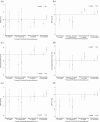Exposure to parental smoking and child growth and development: a cohort study
- PMID: 23842036
- PMCID: PMC3717101
- DOI: 10.1186/1471-2431-13-104
Exposure to parental smoking and child growth and development: a cohort study
Abstract
Background: Studies on adverse childhood health and development outcomes associated with parental smoking have shown inconsistent results. Using a cohort of Belarusian children, we examined differences in cognition, behaviors, growth, adiposity, and blood pressure at 6.5 years according to prenatal and postnatal exposure to parental smoking.
Methods: Using cluster-adjusted multivariable regression, effects of exposure to prenatal smoking were examined by comparing (1) children whose mothers smoked during pregnancy with those of mothers who smoked neither during nor after pregnancy and (2) children whose mothers smoked during and after pregnancy with those whose mothers smoked after pregnancy only; effects of postnatal smoking were examined by comparing (1) children whose mothers smoked after pregnancy only with those of mothers who smoked neither during nor after pregnancy and (2) children whose fathers smoked with those whose fathers did not smoke among children of non-smoking mothers after adjusting for a wide range of socioeconomic and family characteristics.
Results: After adjusting for confounders, children exposed vs unexposed to prenatal maternal smoking had no differences in mean IQ, teacher-rated behavioral problems, adiposity, or blood pressure. Children exposed to maternal postnatal smoking had slightly increased behavioral problems [0.9, 95% CI: 0.6, 1.2 for total difficulties], higher body mass index [0.2, 95% CI: 0.1, 0.3], greater total skinfold thickness [0.4, 95% CI: 0.04, 0.71], and higher odds of overweight or obesity [1.4, 95% CI; 1.1, 1.7]. Similar magnitudes of association were observed with postnatal paternal smoking.
Conclusions: No adverse cognitive, behavioral and developmental outcomes were associated with exposure to maternal prenatal smoking. Observed associations with postnatal smoking of both parents may reflect residual confounding by genetic and family environmental factors.
Figures


Similar articles
-
Parental smoking during pregnancy and risk of overweight and obesity in the daughter.Int J Obes (Lond). 2013 Oct;37(10):1356-63. doi: 10.1038/ijo.2013.101. Epub 2013 May 29. Int J Obes (Lond). 2013. PMID: 23736356 Free PMC article.
-
Mother's environmental tobacco smoke exposure during pregnancy and externalizing behavior problems in children.Neurotoxicology. 2013 Jan;34:167-74. doi: 10.1016/j.neuro.2012.11.005. Epub 2012 Nov 23. Neurotoxicology. 2013. PMID: 23178460 Free PMC article.
-
Association of pre- and post-natal parental smoking with offspring body mass index: an 8-year follow-up of a birth cohort.Pediatr Obes. 2014 Apr;9(2):121-34. doi: 10.1111/j.2047-6310.2012.00146.x. Epub 2013 Feb 18. Pediatr Obes. 2014. PMID: 23420701
-
Impact of maternal smoking on the infant gut microbiota and its association with child overweight: a scoping review.World J Pediatr. 2019 Aug;15(4):341-349. doi: 10.1007/s12519-019-00278-8. Epub 2019 Jul 9. World J Pediatr. 2019. PMID: 31290060
-
Parental smoking and children's respiratory health: independent effects of prenatal and postnatal exposure.Tob Control. 2006 Aug;15(4):294-301. doi: 10.1136/tc.2005.015065. Tob Control. 2006. PMID: 16885578 Free PMC article. Review.
Cited by
-
Prenatal and Childhood Smoke Exposure Associations with Cognition, Language, and Attention-Deficit/Hyperactivity Disorder.J Pediatr. 2023 May;256:77-84.e1. doi: 10.1016/j.jpeds.2022.11.041. Epub 2022 Dec 10. J Pediatr. 2023. PMID: 36513211 Free PMC article.
-
Interactions between Diet and Exposure to Secondhand Smoke on the Prevalence of Childhood Obesity: Results from NHANES, 2007-2010.Environ Health Perspect. 2016 Aug;124(8):1316-22. doi: 10.1289/ehp.1510138. Epub 2015 Dec 29. Environ Health Perspect. 2016. PMID: 26713774 Free PMC article.
-
Maternal smoking and risk of obesity in school children: Investigating early life theory from the GRECO study.Prev Med Rep. 2017 Oct 6;8:177-182. doi: 10.1016/j.pmedr.2017.10.001. eCollection 2017 Dec. Prev Med Rep. 2017. PMID: 29071203 Free PMC article.
-
Effects of promoting longer-term and exclusive breastfeeding on cardiometabolic risk factors at age 11.5 years: a cluster-randomized, controlled trial.Circulation. 2014 Jan 21;129(3):321-9. doi: 10.1161/CIRCULATIONAHA.113.005160. Epub 2013 Dec 3. Circulation. 2014. PMID: 24300437 Free PMC article. Clinical Trial.
-
Developmental toxicity of nicotine: A transdisciplinary synthesis and implications for emerging tobacco products.Neurosci Biobehav Rev. 2017 Jan;72:176-189. doi: 10.1016/j.neubiorev.2016.11.013. Epub 2016 Nov 24. Neurosci Biobehav Rev. 2017. PMID: 27890689 Free PMC article. Review.
References
Publication types
MeSH terms
Substances
Grants and funding
LinkOut - more resources
Full Text Sources
Other Literature Sources
Medical

